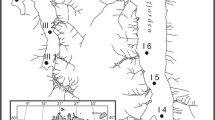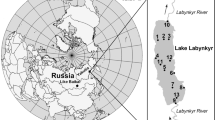Abstract
The diatom flora of three lakes in the ice-free Amery Oasis, East Antarctica, was studied. Two of the lakes are meltwater reservoirs, Terrasovoje Lake (31 m depth) and Radok Lake (362 m depth), while Beaver Lake (>435 m depth) is an epishelf lake. The lakes can be characterized as cold, ultra-oligotrophic and alkaline, displaying moderate (Radok and Terrasovoje lakes) to high (Beaver Lake) conductivities. There was no diatom phytoplankton present in any of the three lakes. While 34 benthic diatom taxa were identified from modern and Holocene sediments of Terrasovoje and Radok lakes, a 30-cm long sediment core recovered in Beaver Lake was barren. Five species (Luticola muticopsis, Muelleria peraustralis, Pinnularia cymatopleura, Psammothidium metakryophilum, P. stauroneioides) are endemic to the Antarctic region. All identified taxa are photographically documented and brief notes on their taxonomy, biogeography and ecology are provided. The most abundant diatom taxa are Amphora veneta, Craticula cf. molesta, Diadesmis spp, M. peraustralis and Stauroneis anceps. This is the first report on the diatom flora in lakes of the Amery Oasis.










Similar content being viewed by others
References
Adamson DA, Mabin MCG, Luly JG (1997) Holocene isostasy and late Cenozoic development of landforms including Beaver and Radok Lake basins in the Amery Oasis, Prince Charles Mountains, Antarctica. Antarct Sci 9:299–306
Battarbee RW (1973) A new method for estimation of absolute microfossil numbers, with reference especially to diatoms. Limnol Oceanogr 18:647–653
Cremer H, Wagner B (2003) The diatom flora in the ultra-oligotrophic Lake El’gygytgyn, Chukotka. Polar Biol 26:105–114
Cremer H, Wagner B, Melles M, Hubberten H-W (2001) The postglacial environmental development of Raffles Sø, East Greenland: inferences from a 10,000 year diatom record. J Paleolimnol 26:67–87
Doran PT, Wharton RA Jr, Lyons WB, Des Marais DJ, Andersen DT (2000) Sedimentology and geochemistry of a perennially ice-covered epishelf lake in Bunger Hills Oasis, East Antarctica. Antarct Sci 12:131–140
Douglas MSV, Smol JP (1999) Freshwater diatoms as indicators of environmental change in the High Arctic. In: Stoermer EF, Smol JP (eds) The diatoms: applications for the environmental and earth sciences. Cambridge University Press, Cambridge, pp 227–244
Duff KE, Zeeb BA, Smol JP (1995) Atlas of chrysophycean cysts. Kluwer, Dordrecht
Håkansson H (2002) A compilation and evaluation of species in the general Stephanodiscus, Cyclostephanos and Cyclotella with a new genus in the family Stephanodiscaceae. Diatom Res 17:1–139
Hodgson DA, Vyverman W, Sabbe K (2001) Limnology and biology of saline lakes in the Rauer Islands, eastern Antarctica. Antarct Sci 13:255–270
Johansen JR (1999) Diatoms of aerial habitats. In: Stoermer EF, Smol JP (eds) The diatoms: applications for the environmental and earth sciences. Cambridge University Press, Cambridge, pp 264–273
Jones VJ (1996) The diversity, distribution and ecology of diatoms from Antarctic inland waters. Biodiv Conserv 5:1433–1449
Kellogg T, Kellogg DE (2001) Non-marine diatoms from Antarctic and Subantarctic regions. Distribution and updated taxonomy. Diatom Monogr 1:1–795
Kellogg DE, Stuiver M, Kellogg TB, Denton GH (1980) Non-marine diatoms from Late Wisconsin perched deltas in Taylor Valley, Antarctica. Palaeogeogr Palaeoclimatol Palaeoecol 30:157–189
Ko-bayashi T (1965) Variation on some pennate diatoms from Antarctic—2. Jap Antarct Res Exp 1956–1962 Sci Rep Ser E 24:1–28
Krammer K, Lange-Bertalot H (1986) Bacillariophyceae 1: Naviculaceae. (Süsswasserflora von Mitteleuropa, Band 2/1) Spektrum Akademischer Verlag, Heidelberg
Krammer K, Lange-Bertalot H (1988) Bacillariophyceae 2: Bacillariaceae, Epithemiaceae, Surirellaceae. (Süsswasserflora von Mitteleuropa, Band 2/2) Spektrum Akademischer Verlag, Heidelberg
Krammer K, Lange-Bertalot H (1991) Bacillariophyceae 3: Centrales, Fragilariaceae, Eunotiaceae. (Süsswasserflora von Mitteleuropa, Band 3/4) Spektrum Akademischer Verlag, Heidelberg
Laybourn-Parry J (2002) Survival mechanisms in Antarctic lakes. Phil Trans R Soc Lond Ser B 357:863–869
Laybourn-Parry J, Quayle WC, Henshaw T, Ruddell A, Marchant HJ (2001) Life on the dge: the plankton and chemistry of Beaver lake, an ultraoligotrophic epishelf lake, Antarctica. Freshwater Biol 46:1205–1217
Laybourn-Parry J, Quayle WC, Henshaw T (2002) The biology and evolution of Antarctic saline lakes in relation to salinity and trophy. Polar Biol 25:542–552
Lee RE (1999) Phycology. Cambridge University Press, Cambridge
Oppenheim DR, Greenwood R (1990) Epiphytic diatoms in two freshwater maritime Antarctic lakes. Freshwater Biol 24:303–314
Pankow H, Haendel D, Richter W (1991) Die Algenflora der Schirmacheroase (Ostantarktika). Beih Nova Hedwigia 103:1–197
Quayle WC, Peck LS, Paet H, Ellis-Evans JC, Harrigan PR (2002) Extreme responses to climate change in Antarctic lakes. Science 295:645–650
Roberts D, McMinn A (1998) A weighted-averaging regression and calibration model for inferring lake water salinity from fossil diatom assemblages in saline lakes of the Vestfold Hills: a new tool for interpreting Holocene lake histories in Antarctica. J Paleolimnol 19:99–113
Roberts D, McMinn A (1999) Diatoms of the saline lakes of the Vestfold Hills, Antarctica. Bibl Diatomol 44:1–83
Roberts D, McMinn A, Zwartz D (2000) An initial palaeosalinity history of Jaw Lake, Bunger Hills based on a diatom-salinity transfer function applied to sediment cores. Antarct Sci 12:172–176
Roberts D, McMinn A, Johnston N, Gore DB, Melles M, Cremer H (2001) An analysis of the limnology and sedimentary diatom flora of fourteen lakes and ponds from the Windmill Islands, East Antarctica. Antarct Sci 13:410–419
Sabbe K, Verleyen E, Hodgson DA, Vanhoutte K, Vyverman W (2003) Benthic diatom flora of freshwater and saline lakes in the Larsemann Hills and Rauer Islands, East Antarctica. Antarct Sci 15:227–248
Schmidt R, Mäusbacher R, Müller J (1990) Holocene diatom flora and stratigraphy from sediment cores of two Antarctic lakes (King George Island). J Paleolimnol 3:55–74
Seaburg KG, Parker BC, Prescott GW, Whitford LA (1979) The algae of Southern Victoria Land, Antarctica. Bibl Phycol 46:1–124
Spaulding SA, McKnight DM (1999) Diatoms as indicators of environmental change in Antarctic freshwaters. In: Stoermer EF, Smol JP (eds) The diatoms: applications for the environmental and earth sciences. Cambridge University Press, Cambridge, pp 245–263
Spaulding SA, Stoermer EF (1997) Taxonomy and distribution of the genus Muelleria Frenguelli. Diatom Res 12:95–115
Spaulding SA, McKnight DM, Stoermer EF, Doran PT (1997) Diatoms in sediments of perennially ice-covered Lake Hoare, and implications for interpreting lake history in the McMurdo dry valleys of Antarctica. J Paleolimnol 17:403–420
Spaulding SA, Kociolek JP, Wong D (1999) A taxonomic and systematic revision of the genus Muelleria (Bacillariophyta). Phycologia 38:314–341
Van de Vijver B, Beyens L (1996) Freshwater diatom communities of the Strømness Bay area, South Georgia. Antarct Sci 8:359–368
Van de Vijver B, Beyens L (1997) Freshwater diatoms from some islands in the maritime Antarctic region. Antarct Sci 9:418–425
Van de Vijver B, Beyens L (1999) Freshwater diatoms from Ile de la Possession (Crozet Archipelago, sub-Antarctica): an ecological assessment. Polar Biol 22:178–188
Van de Vijver B, Frenot Y, Beyens L (2002) Freshwater diatoms from Ile de la Possession (Crozet Archipelago, Subantarctica). Bibl Diatomol 46:1–412
Verleyen E, Hodgson DA, Vyverman W, Roberts D, McMinn A, Vanhoutte K, Sabbe K (2003) Modelling diatom responses to climate induced fluctuations in the moisture balance in continental Antarctic lakes. J Paleolimnol 30:195–215
Wagner B (2003) The expeditions Amery Oasis, East Antarctica, 2001/02 and Taylor Valley, southern Victoria Land, 2002. Rep Pol Mar Res 460:1–69
Wagner B, Cremer H, Hultzsch N, Gore DB, Melles M (2004) Late Pleistocene and Holocene history of Lake Terrasovoje, Amery Oasis, East Antarctica, and its climatic and environmental implications. J Paleolimnol (in press)
Wand U, Hermichen W-D, Höfling R, Mühle K, Klokov VD, Ufimcev AV (1987) Stable isotope and hydrogeochemical studies of Beaver Lake and Lake Radok, MacRobertson Land, East Antarctica. In: Wand U, Strauch G (eds) Isotopes in Nature. Academy of Sciences, Leipzig, pp 647–659
Wasell A, Håkansson H (1992) Diatom stratigraphy in a lake on Horseshoe Island, Antarctica: a marine-brackish-freshwater transition with comments on the systematics and ecology of the most common diatoms. Diatom Res 7:157–194
Acknowledgements
The authors thank Gerald Müller (AWI, Potsdam) and Martin Klug (University of Leipzig) for field assistance and Antje Eulenberg (AWI, Potsdam) for laboratory assistance. This study is supported by the research project “Palaeoenvironments of the Antarctic coast, from 50°E to 120°E”, funded by the Australian Antarctic Scientific Advisory Committee (Kingston, Tasmania; ASAC Grant No. 1071). The manuscript benefitted from the valuable comments of three anonymous referees who also contributed to an improvement of the language.
Author information
Authors and Affiliations
Corresponding author
Rights and permissions
About this article
Cite this article
Cremer, H., Gore, D., Hultzsch, N. et al. The diatom flora and limnology of lakes in the Amery Oasis, East Antarctica. Polar Biol 27, 513–531 (2004). https://doi.org/10.1007/s00300-004-0624-2
Received:
Revised:
Accepted:
Published:
Issue Date:
DOI: https://doi.org/10.1007/s00300-004-0624-2




